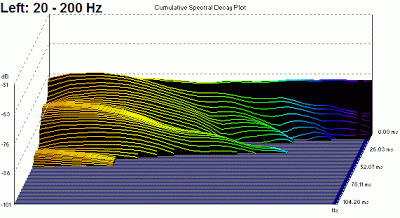Disclaimer: Measurement has been carried out with acoustic leak minimized, by using a silicone putty as a sealant.
Electrostatic headphones are said to have a wide sound stage, exceptional detail, and flat frequency response, easily surpassing the sound quality of any moving-coil headphones. Carl A. Poldy, the designer of AKG K1000 earspeakers, explains the basic principle of electrostatic drivers this way:
"The electrostatic transducer consists of a charged membrane, usually supported at its edges, and driven in an electric field modulated by the sound signal."
Once the stators are charged, the d.c. polarized diaphragm starts to move towards the opposite charge, creating a sound wave in push-pull motion as the polarity is switched between the stators. Theoretically, the entire surface of the diaphragm acts uniformly at once in phase to the input signal, preventing a motion break, caused by uneven vibrational modes, from occurring. On top of that, the low-mass diaphragm yields a flat&well-extended frequency response and a fast transient characteristic.
However, in order to secure a linear low frequency response, tight seal is a must, according to the British audio engineer Peter J. Baxandall. Acoustic leak will most likely push the resonance of the diaphragm to higher frequency range, by cutting off the bandwidth in the lower end:
"...a given electrically produced force, at some specific low frequency, will now produce a much larger diaphragm velocity....the total stiffness is very much reduced, being only that resulting from the diaphragm tension and electrical negative stiffness."
Introduced in 1982 as a successor of the original Stax SR-lambda(Λ), SR-lambda Professional is the very first electrostatic earspeaker featuring 580 V bias(professional) voltage from the manufacturer. With the diaphragm 0.5 µm thinner than that of the predecessor, the manufacturer claim distortion has been reduced dramatically.
Moreover, this very headphone is an important piece of history of the headphone industry, as it has been featured in numerous research papers, including the well-known study of 1985, which helped standardize the diffuse-field reference, by Günther Theile. Furthermore, With the help of Institut für Rundfunktechnik(IRT), Stax come up with an equalizer, ED-1, which can turn SR-Λ Professional into an accurate diffuse-field simulator.
CON: A good acoustic seal is vital for sound reproduction below 100 Hz.
ON SECOND THOUGHT #1: It is such a shame that the cable is not replaceable.
However, an accurate diffuse-field headphone may sound too harsh & bright for some listeners, according to Olive and Welti. If that happens to be the case, coupling ED-1 to current SR-lambda based models should resolve the issue, as they have a slight attenuation in the treble. The consequential spectral balance will be close to that of a downward sloped diffuse-field target, which will be more comfortable to listen to.
ON SECOND THOUGHT #3: A free-field analysis has been carried out at various locations within the frontal volume of the housing using an accurately calibrated microphone. The test result suggests that the entire surface of SR-Lambda Professional's diaphragm is not behaving as uniform as originally expected.
ON SECOND THOUGHT #4: By default, this headphone is far from the Olive-Welti target, meaning that the tonality is simply too harsh to be considered as hi-fidelity. A substantial amount of equalization is needed here.
References
C. A. Poldy, Chapt. 12 in Loudspeaker and headphone handbook, Borwick, J., ed., Oxford: Reed, 1994.
G. Theile, "On the Standardization of the Frequency Response of High-Quality Studio Headphones," Journal of the Audio Engineering Society, Vol.34 No.12 (December 1986).
G. Theile, "The Importance of Diffuse-field Equalization for Stereophonic Recording and Reproduction," 13. Tonmeistertagung München, 1984.
P. J. Baxandall, Chapt. 3 in Loudspeaker and headphone handbook, Borwick, J., ed., Oxford: Reed, 1994.
S. Olive, T. Welti, and M. Elisabeth, "Listener Preferences for Different Headphone Target Response Curves," presented at the 134th Audio Eng. Soc. Convention, preprint 8867 (May 2013).










Well Done!
ReplyDeleteWow you are fast, Jim. Thnx!
Delete